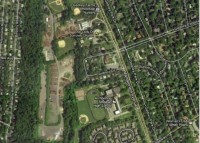White Plains Considers $10.15 Million Bond for Gedney Landfill

The Gedney Way Landfill has been closed for almost 35 years, yet final capping of the former incinerator ash dumping site is only now on schedule for completion; a one-year project that is expected to be finalized in the fall of 2013.
At a meeting of the White Plains Capital Projects Board on Monday morning, June 25, Department of Public Works Commissioner Joseph (Bud) Nicoletti explained that bids on the New York State Department of Environmental Conservation approved capping plan, as developed by White Plains and AKRF Environmental Consultants, had been reviewed.
“With some modifications to the spec and discussions with contractors and different sub-contractors, we were able to reduce the lowest bid from $12.4 million to $10.15 million,” Nicoletti told members of the board. Initial estimates had put the cost of capping the site in the $8 million ballpark. The lowest bid came in $4.4 million over expectations.
Nicoletti noted that an estimated $1 million of further expense could be expected and 5 percent of the total cost should be considered as a contingency budget for unknowns that might arise during the capping. As an example, Nicoletti, cited the need to move the plastics recycling and fall leaf collection and composting to other areas of Gedney Yard during capping activities.
The Capital Projects Board recommended issuance of a bond for the $10.15 million amount. That bond was expected to be discussed and approved at a Special Meeting of the Common Council later on Monday afternoon. Commissioner Nicoletti also informed the group that a NYS DEC grant program was in effect to possibly reimburse the city of funds spent on the project.
The history of the landfill goes back to 1948 when White Plains initiated disposal of residual ash from its municipal solid waste incinerator at the site. At various times during the disposal history, municipal solid waste, construction and demolition debris, and other miscellaneous wastes were deposited, although the site was primarily used for the disposal of ash fill. On July 21, 1978, the NYSDEC issued a sanitary landfill permit to White Plains, allowing the facility to accept household bulk waste, tree trimmings and leaves on the existing incinerator residue landfill. Waste disposal at the facility ceased in 1979. The facility was converted to a leaf storage and processing facility in 1980. The permit was renewed in 1981 and the renewal included a requirement for the city to submit to the NYSDEC an acceptable landfill closure plan six months prior to ceasing waste acceptance activities. The city subsequently placed a soil cap over the footprint of the landfill. The ball field at Our Lady of Sorrows school was also subsequently capped with a foot and a half of soil. Since disposal operations were ceased in 1979, the facility has been used to process leaves, yard waste, stumps and brush generated within White Plains city limits. The facility has also been used for storage of materials, including guard rails, curbing, gravel, highway barriers, drain pipes and snow plows and spreaders to support Department of Public Works operations.
In addition to the ash landfill, further investigations initiated in 1986 documented an area of solvent contaminated soil in the southern end of the landfill area and stormwater sampling found chlorinated solvents in stormwater outfalls. Sampling was undertaken to identify leaks into stormwater lines. Four drum disposal areas, accounting for a total of 46 drums, were identified adjacent to the stream bank along the southeastern side of the facility, during an investigation done by Malcolm Prime, Inc., an environmental consulting firm, from 1999 to 2003. The drums were removed. Surface water sampling showed lower results compared to 1987. To 2006, Malcolm Prime continued to investigate the site. Borings in the ash fill showed that methane was present in pockets throughout the site and test pits determined the size and boundaries of the ash fill. Additionally, during groundwater sampling, TCE-trichloroethylene and breakdown compounds became the primary contaminants of concern on the southern portion of the site.
During Monday’s Capital Projects Board meeting, Commissioner Nicoletti said that 164 test wells had been dug at the landfill over the past six years and that testing was ongoing.
The closure plan requires a full cover system at the southern end of the landfill. The closure of the remaining landfill area will require a minimum of two feet of clean soil cover. Re-lining and sealing of the southern-most stormwater line was completed in 2006. Similar work will be conducted on the northernmost stormwater lines.
At the Capital Projects Board meeting, Mayor Tom Roach said: “Thirty-five years is a long time. We need to cap this landfill. We are obligated to do so and we will do it right.”
In an interview with The White Plains Examiner, Councilwoman Milagros Lecuona said, “The landfill has been an issue for many, many, many years. Each administration knew they’d be putting millions of dollars into it and no one would really see it. This is not what you’d call sexy work.”
The Gedney Landfill closing plan can be viewed at cityofwhiteplains.com under the Department of Public Works.


